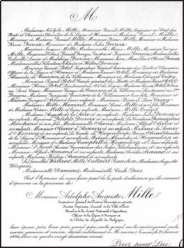- MILLE
- FRANCE (see also List of Individuals)\
 9.10.1812 Lille/F - 20.1.1894 M'raissa/Tunesia\Adolphe-Auguste Mille graduated in 1834 from Ecole Polytechnique and two years later from Ecole des Ponts et Chaussées. He was then attached to the lighthouse service in Brittany and from 1840 to the railroad service of Lille. In 1847, Mille returned to Paris where he took interest in water treatment, then an important engineering issue for a city as large as the capital. At the end of his 1854 paper, Mille stated that "hygiene of a city and agriculture need a novel system of sewage treatment. Each house should be connected to a sewer to create a natural circle." The sewage was diverted from 1856 on test fields to investigate its effect on plantations. In 1859 already, Mille noted a success with the new wastewater fields.\During the 1860s and 1870s Eugène Belgrand (1810-1878) had erected the Paris sewer system yet the sewage was directly diverted into Seine River, causing a terrible water quality. Mille was confident with a solution in which the water circle would be closed: Instead of adding the sewage to the receiving waters, it should be used for irrigating agriculture. The city of Gennevilliers Northwest of Paris was considered adequate for these purposes. Until 1870 many a curious visitor wanted to see how sewage was used for agricultural production. Despite the Franco-Prussian War in 1870/71 development was noted, once Belgrand was convinced from the advantages for the capital. By 1874 the Ministry of Public Works stated that sewage purification by soil was a technically sound method. Mille was promoted to General Inspector in 1873 and awarded the Officier Cross of Légion d'Honneur in 1876. His successor Alfred Durand-Claye (1841-1888) enlarged the sewage fields against public advice, once Mille had retired in 1877.\Bechmann, G. (1894). Notice biographique sur M. Mille, Inspecteur Général des Ponts et Chaussées. Annales des Ponts et Chaussées 64(1): 721-734.Bechmann, G. (1900). Le service des eaux et de l'assainissement de Paris. Béranger: Paris. Belgrand, E., Mille, A. (1854). Mémoire sur les eaux de Paris présenté à la Commission Municipale. Vinchon: Paris.Cheysson, E. (1897). Mille. Ecole Polytechnique - Livre de Centenaire 1794-1894 3: 375-376.Gauthier-Villars: Paris.Mille, A. (1867). Sur le drainage de Londres et l'utilisation des eaux d'égout en Angleterre. Annales des Ponts et Chaussées 37(2): 198-226.Mille, A. (1885). Assainissement des villes par l'eau, les égouts, les irrigations. Dunod: Paris. Vilbas, J. (2007). Adolphe Mille. Personal communication. Bibliothèque Municipale: Lille. P
9.10.1812 Lille/F - 20.1.1894 M'raissa/Tunesia\Adolphe-Auguste Mille graduated in 1834 from Ecole Polytechnique and two years later from Ecole des Ponts et Chaussées. He was then attached to the lighthouse service in Brittany and from 1840 to the railroad service of Lille. In 1847, Mille returned to Paris where he took interest in water treatment, then an important engineering issue for a city as large as the capital. At the end of his 1854 paper, Mille stated that "hygiene of a city and agriculture need a novel system of sewage treatment. Each house should be connected to a sewer to create a natural circle." The sewage was diverted from 1856 on test fields to investigate its effect on plantations. In 1859 already, Mille noted a success with the new wastewater fields.\During the 1860s and 1870s Eugène Belgrand (1810-1878) had erected the Paris sewer system yet the sewage was directly diverted into Seine River, causing a terrible water quality. Mille was confident with a solution in which the water circle would be closed: Instead of adding the sewage to the receiving waters, it should be used for irrigating agriculture. The city of Gennevilliers Northwest of Paris was considered adequate for these purposes. Until 1870 many a curious visitor wanted to see how sewage was used for agricultural production. Despite the Franco-Prussian War in 1870/71 development was noted, once Belgrand was convinced from the advantages for the capital. By 1874 the Ministry of Public Works stated that sewage purification by soil was a technically sound method. Mille was promoted to General Inspector in 1873 and awarded the Officier Cross of Légion d'Honneur in 1876. His successor Alfred Durand-Claye (1841-1888) enlarged the sewage fields against public advice, once Mille had retired in 1877.\Bechmann, G. (1894). Notice biographique sur M. Mille, Inspecteur Général des Ponts et Chaussées. Annales des Ponts et Chaussées 64(1): 721-734.Bechmann, G. (1900). Le service des eaux et de l'assainissement de Paris. Béranger: Paris. Belgrand, E., Mille, A. (1854). Mémoire sur les eaux de Paris présenté à la Commission Municipale. Vinchon: Paris.Cheysson, E. (1897). Mille. Ecole Polytechnique - Livre de Centenaire 1794-1894 3: 375-376.Gauthier-Villars: Paris.Mille, A. (1867). Sur le drainage de Londres et l'utilisation des eaux d'égout en Angleterre. Annales des Ponts et Chaussées 37(2): 198-226.Mille, A. (1885). Assainissement des villes par l'eau, les égouts, les irrigations. Dunod: Paris. Vilbas, J. (2007). Adolphe Mille. Personal communication. Bibliothèque Municipale: Lille. P
Hydraulicians in Europe 1800-2000 . 2013.
